A strong national defense depends on a well-supported military. Members of the armed services and their families are the most important resource the U.S. has in terms of national defense. Individuals who have served deserve to be well-served through education opportunities for themselves and their children that enable the pursuit of life and career goals.
All military members volunteer to deploy into harm’s way. For a service member preparing for deployment or already deployed far from home, the education options available to their children can be a point of great concern. The schooling options available to military-connected children can play a role in whether a family accepts an assignment, even factoring into decisions to leave military service altogether.[REF] Yet as important as education is to military parents, more than half of all active-duty military families live in states with no school choice options at all.
In order to ensure that those who secure our nation are able to access education options that best serve them, policymakers should empower these families with education choice options through the federal Impact Aid program, which was designed largely with military-connected children in mind. Specifically, Congress should:
- Direct the federal Impact Aid program, which provides additional funding to districts with a military population, to military-connected children themselves, instead of to public school districts.
- Re-conceptualize the $1.3 billion Impact Aid program in a way that creates school choice for military families, empowering parents with the ability to choose what works for their children and ensuring that a service member’s decision to remain in the military does not hinge on outdated assignment-by-zip-code schooling policies.
- Transition Impact Aid funding into parent-controlled education savings accounts (ESAs) to provide children of active-duty military families with education choice, while ensuring the federal program serves military families so that they can serve the nation.
Lack of Existing Education Options for Military-Connected Children
A strong national defense depends on a well-supported military. Supporting the military includes making education options available to military-connected children. More than 1.3 million Americans made up the (active-duty) armed forces of the United States in 2015,[REF] with more than 87 percent of active-duty service members residing in the United States and the U.S. territories. The typical enlisted service member is 27 years old, with the average age for officers increasing to 34.5 years of age.[REF] The age of most military personnel means many have children school-aged and younger; these children are more than 1.2 million in number.
Today, lack of adequate academic achievement, combined with a lack of physical fitness and in some cases, the presence of criminal records, means that more than 70 percent of Americans age 17 to 24 cannot qualify for military service. Moreover, 20 percent of high school graduates who hope to join the Army—which, at 36 percent of the overall armed forces personnel, comprises the largest portion of active-duty military members[REF]—cannot achieve an adequate score on the Armed Forces Qualification Test to do so. In Hawaii, Louisiana, Alabama, and South Carolina, this figure exceeds 30 percent.[REF] Children from military families are much more likely to serve in the military themselves. According to the 2016 Blue Star Family Military Family Lifestyle Survey, while only 0.5 percent of the general public is currently serving, 56 percent of their veteran and active-duty respondents reported multiple immediate family members who were veterans or currently serving.[REF] Because future recruitment depends in large part on military-connected youth, it is in the nation’s best interest to ensure that these children are adequately prepared not simply to pass a basic qualification test, but to excel during their service years afterward. The future success of our armed services depends on offering military-connected children an excellent education.
Military readiness is affected by the quality of education available to children of military families. The quality of educational options available to military families can play a role in whether a family accepts an assignment or even decides to leave military service altogether.[REF] According to a recent survey conducted and published by Military Times, 35 percent of respondents said that dissatisfaction with their child’s education was a “significant factor” in their decision to remain in or leave military service.[REF] The Pentagon’s changes to policy in 2016 enabling families to remain at duty stations for longer time periods was a direct response “to complaints by military parents who are loathe to move if the next duty station has poorly performing schools.”[REF]
Those complaints may stem from the fact that military-connected children are too often assigned to the district schools closest in proximity to military bases, regardless of whether those district schools are right for them.
- 80 percent of the 1.2 million military-connected children in the U.S. who are school age attend traditional public schools, and
- 4 percent attend Department of Defense (DOD) schools located on military bases.
Many families receive assignments on bases located in states that do not even offer the most basic of school choice options: inter-district public school choice. Moreover, more than half of children of active-duty military families live in states with no school choice options at all. (See Table 1.) Even those who are stationed in states with school choice programs are all too often limited by program eligibility, as most state school choice programs are limited to children from low-income families, children with special needs, or otherwise cap participation. For example:
- California and Texas, the two states with the largest concentration of military-connected families, have no private school choice options;
- North Carolina, with the third highest number of active-duty military personnel in the country at 106,000 members, does have two voucher programs, but they are modest in scope, limited to children with special needs and children from low-income families;[REF] and
- Georgia and Virginia, the other states with the largest concentration of military-connected personnel, have private school choice options that are limited, either in terms of student eligibility or aggregate funding caps.
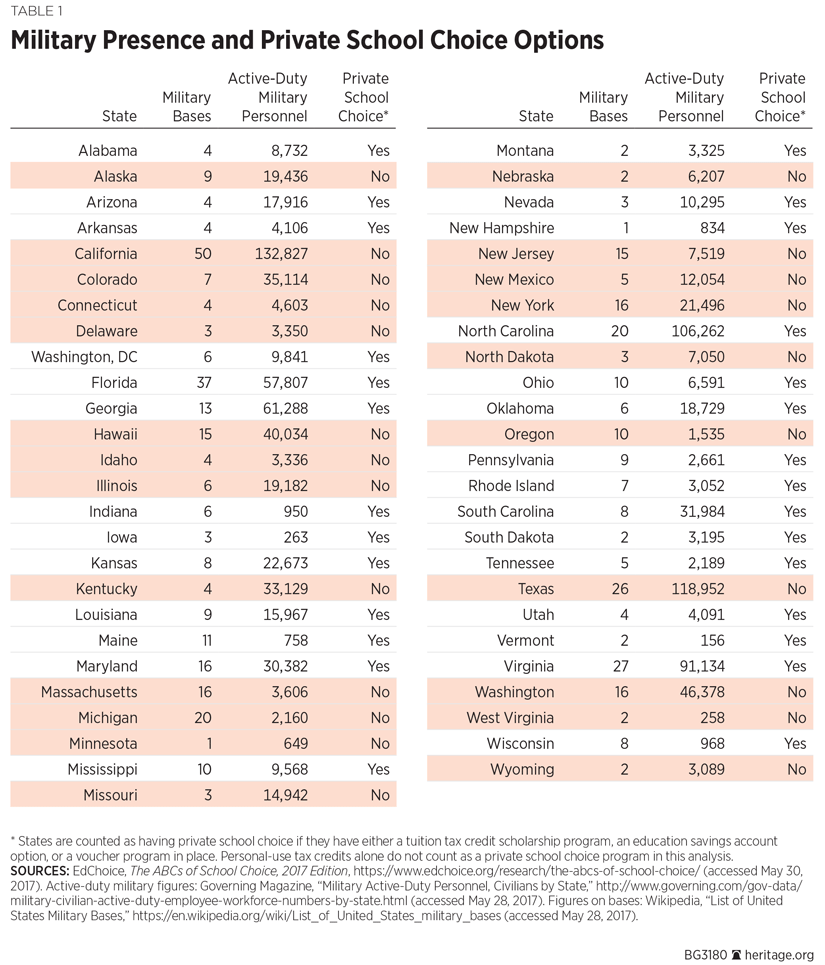
Choice for Military Families Through Federal Policy
Providing for national defense is an explicitly enumerated power of the federal government. Six of the 17 enumerated powers in Article 1, Section 8 of the U.S. Constitution pertain to the military and national defense. The Constitution outlines three key tenets of federal responsibility and purpose vis à vis national defense:
- National defense is the responsibility and first priority of the federal government (Article 1, Section 9);
- The federal government is mandated to provide for national defense (Article 4, Section 4); and
- National defense is exclusively the function of the federal government (Article 1, Section 10).[REF]
The federal government’s exclusive responsibility and mandate to oversee national defense and the military extends to military-related issues that impact education. Whereas education is not an enumerated power of the federal government per the U.S. Constitution, national defense is clearly so, and the education of military-connected children has a special place as a Department of Education (DOE) program. Since it pertains to the U.S. military, Impact Aid is one of the few federal programs dealing with education that has constitutional warrant. Just as there is no question, constitutionally speaking, that the federal government has authority over the military, so also does the federal government have authority to implement or modify programs that provide federal funding to military families.
History of Federal Involvement in Education of Military-Connected Children
The federal government is directly responsible for the support and strength of the military; in turn, the military cares for and supports the men, women, and families who serve. Since 1775, when George Washington established the first military base at West Point, military bases have served as home and focal point for servicemen and their families. Families lived on base, shopped for food on base at the commissary, saw military doctors in military hospitals, and—until the past 60 years—did most of this in relative isolation. Military bases were located in removed areas, and needed to provide military dependents with all the necessities of life, including education. As American common schools (precursors to today’s public schools) sprang up during the 1800s, commanding officers began establishing schools on military installations.[REF] In 1821, Congress officially authorized the operation of these dependent schools, and the military took on responsibility for educating military children.[REF]
Massive military growth during and after World War II strained the system as new servicemen and their families moved to military installations and surrounding areas, and as women went to work in the munitions industry. To address these growing needs, Congress passed the Defense Housing and Community Facilities and Services Act of 1940—popularly known as the Lanham Act—to provide funds for war housing, new schools, childcare, and other support for families who were contributing to the war effort. However, the communities around military bases bore the brunt of the increased population as military children flooded the local school systems.[REF]
In 1950, five years after troops began to return home at the war’s end and rejoin their families, Congress passed Public Law No. 81–874, among the first federal education programs. Commonly known as Impact Aid, this legislation established “Section 6” schools on military bases and provided funding for federally connected children who remained in local school districts.[REF] The military had long been accustomed to providing schooling for children living on bases—Impact Aid shifted responsibility for the education of military children from military commanders and the DOD to the Office of Education. A few years later, children living on certain tribal lands were included in statute, and districts began to receive Impact Aid funds for these federally connected children as well.[REF]
Military and Civilian Communities
In the decades that followed, more and more military children were educated in local school districts and the number of base schools dropped dramatically as cities and suburbs grew out toward military bases. The military community became less isolated and base-centric and more diffused and integrated with civilian populations, living in civilian communities off base with their housing subsidies. In 1981, the Omnibus Reconciliation Act shifted funding responsibility for “Section 6” schools from the DOE back to the DOD, and the now separate small system of base schools was renamed the Department of Defense Domestic Dependent Elementary and Secondary Schools (DDESS).[REF]
Today, many military personnel are concentrated in the heart of developed civilian areas. Areas like San Diego, California, Jacksonville, Florida, and Fairfax County, Virginia, are bustling metropolitan areas where civilian and military families work and live in close proximity.
Despite proximity and integration, military families face unusual challenges particularly in the area of education. These challenges include frequent moves and base assignments near failing schools or schools that do not suit their children. In the key findings of a recent study from the Lexington Institute, Don Soifer and Doug Mescar concluded:
A shortage of high-quality educational options for military-connected families and students—from schools to programs within schools—often restricts education opportunities, negatively impacts education achievement, causes military families to make tough housing choices, inhibits quick assimilation into school communities, and can reduce a family’s satisfaction with a military career.[REF]
Because of these difficulties and because many military families cannot afford private school tuition, homeschooling has become a popular option. Military families homeschool at twice the rate of the civilian population with about 7 percent of military families choosing the flexibility, continuity, and rigor of a parent-directed education.[REF] The parents who do not choose to homeschool must rely on the public school district around the base or on the DOD-operated school on base, unless they can afford to pay directly for private school.
Department of Defense Domestic Dependent Elementary and Secondary Schools
Currently, the DOD operates or contracts with local educational agencies to operate 57 schools on 15 out of the 204 military installations in the contiguous United States.[REF] In 2014, a total of 25,911 students were enrolled in DDESS or DDESS special arrangements with local districts—a mere 4 percent of the total number of military-connected school age children in the contiguous United States.[REF] While all dependent children of DOD employees living on base are eligible to attend the DDESS schools tuition-free, eligibility varies for families who live off base, and many of these families send their children to the local schools.[REF]
These DDESS schools are located only along the East Coast, with the highest concentrations in North Carolina around Fort Bragg and Camp Lejeune, and in Kentucky around Fort Knox and Fort Campbell.[REF] Section 2164 of Title 10 allows the Secretary of Defense to operate these types of schools based on two factors:
- Whether military-connected children are able to receive free public education from the local area, and
- How capable the local educational agency is of providing an appropriate education.[REF]
In most cases, the local district schools in areas near bases with DDESS schools are not providing an adequate education and are struggling to keep up with national averages of academic performance. In these scenarios, DDESS schools are an important addition to life on base. DDESS schools perform at or substantially above national averages and their respective state public school averages on fourth-grade and eighth-grade National Assessment of Educational Progress tests, and military parents get to be heavily involved in school decision making.[REF]
While DDESS schools provide a valuable option for military families on bases near struggling public schools, the DOD is actively considering whether it should continue to operate a domestic school system or if a better alternative exists to provide quality education in a more cost-effective way.[REF]
This tiny school system is expensive to maintain.
- In 2015, the total operating budget was $935 million—one-third of the total budget for all Department of Defense Education Activity (DODEA) worldwide.
- In 2014, average per pupil expenditure at DDESS schools was $26,682.[REF]
- In 2013, the national average per pupil spending was $12,296.[REF] The DDESS average per pupil expenditure is more than twice that.
As military and civilian communities continue to overlap and integrate, the DOD is evaluating whether it needs to provide the types of wraparound services necessitated by life on isolated military bases. If the DDESS system is adapted for modern times through adoption of an Education Savings Account program for DDESS families, military parents could choose high-quality education options for their children and the potential financial savings could be re-invested in core national defense priorities.
Impact Aid: Federally Connected Children and the Public System
The purpose of the Impact Aid program is twofold:
- To support the provision of education services for federally connected children, and
- To compensate local areas for lost tax revenue.
Local areas lose property tax revenue when untaxable federally owned lands or tribal lands are present, and can also lose revenue because they are unable to collect property or other taxes from the individuals—civilian or military—who live and work on federal or tribal lands. In many cases, military families pay taxes to their original states and localities, even though they spend their lives moving from place to place in other parts of the country and enrolling their children in local school systems.
Title VIII of the Elementary and Secondary Education Act (ESEA) authorizes several types of Impact Aid payments.
- Payments under Section 8002 compensate local education agencies (LEAs) for federal ownership of property;
- Payments under Section 8003 compensate LEAs for enrolling and educating federally connected children—known as Basic Support Payments;
- Section 8007 authorizes competitive grant funding for construction and facility improvement in LEAs that enroll high percentages of federally connected children; and
- Section 8008 provides funds for repair and maintenance of 11 schools that are owned by the DOE but operated by the LEA in order to serve federally connected children.
See the Appendix for a more detailed discussion of Impact Aid and how it is distributed.
Impact aid is distributed under all four of the above categories, but the heart of this program is devoted to funding federally connected children. In 2016, the Impact Aid program was authorized at $1.3 billion, with $1.168 billion directed to Basic Support Payments under Section 8003(b) and another $48.3 million directed to children with special needs under Section 8003(d).
Both the Obama and Trump Administrations have made it clear that the focus of Impact Aid is serving the needs of federally connected children, not simply replacing lost tax revenue. In recent budget requests, both Administrations have tried to eliminate payments for federal property, arguing that LEAs have had plenty of time to adjust their tax rolls to federal acquisitions made decades ago, and that Impact Aid funds should be directed to federally connected children. The fiscal year (FY) 2017 Budget Request from the Obama Administration’s Department of Education stated:
It is the Administration’s policy to use available Impact Aid funds to help pay for the education of federally connected children and fund programs that serve federally connected children. Payments for Federal Property compensates LEAs for lost property tax revenue due to the presence of federal lands without regard to whether those districts educate any federally connected children as a result of the Federal presence.[REF]
Of the approximately 1.2 million children of active-duty families, the total number of school age children is around 750,000.[REF] With roughly 13 percent of military-connected children in DODEA schools around the world and at home (DDESS schools) and roughly 7 percent homeschooled, the civilian public school system supports the education of the remaining 80 percent of that population.[REF] Data from the DOE show that 756,446 federally connected children (military-connected and tribal-lands-connected) were reported in the public school system in 2016.[REF]
Despite federal taxpayers’ investment in military readiness and its significant investment in these children in the form of Impact Aid, no research on outcomes, performance, or parental satisfaction exists for the military-connected subgroup of students. The Every Student Succeeds Act (ESSA), a rewrite of No Child Left Behind and the most recent reauthorization of the ESEA, addressed this issue by adding requirements for a military student identifier.
The most critical policy reform needed to empower the parents of military-connected children is allowing for choice in education for service members and their children. The federal government should take steps to improve its support for military-connected children and children from tribal lands by making Impact Aid funding student-centered and portable in the form of Education Savings Accounts (ESAs).[REF]
Education Savings Accounts
Like their civilian-family counterparts, children of military families deserve a choice in where they attend school. One of the best ways to advance choice is through innovative ESAs. ESAs are parent-controlled accounts funded with a portion (usually 90 percent) of what a given state would have spent on a child in the district school system. Across the U.S., five states have established ESA options:
- Arizona,
- Florida,
- Tennessee,
- Mississippi, and
- Nevada.
The Case of Arizona. In Arizona, the first state to adopt ESAs, parents who enter the ESA option receive 90 percent (approximately $5,000 on average) of what the state would have spent on their child in their public schools. Funds are deposited quarterly into the ESA (going onto a debit card), and parents can then direct those funds to any education-related service, product, or provider. Parents can use those funds to pay for private school tuition, online learning, special education services and therapies, private tutors, textbooks, curricula, and any other education-related services of their choice. Notably, unused funds can even be rolled over from year-to-year, and can be rolled into a college savings account in some cases.
Parents are using the flexibility created through ESAs to craft customized educational experiences for their children. Nearly one-third of parents use their ESAs to craft a fully à la carte educational experience for their children.
- During the 2011–2012 school year, 34 percent of account holders used their ESA for multiple services and products, such as tuition along with a private tutor and education therapies.
- During the 2013–2014 and 2014–2015 school years, approximately 28 percent of parents used their accounts to customize their child’s education.
A traditional private school voucher program, while a good option, limits the account holder to paying private school tuition only. ESAs enable participants to access any learning option (tuition or otherwise) that meets their unique learning needs. The data from Arizona demonstrate that with the passage of time, a considerable portion of parents continue to use ESAs to create a completely customized education experience for their children.[REF]
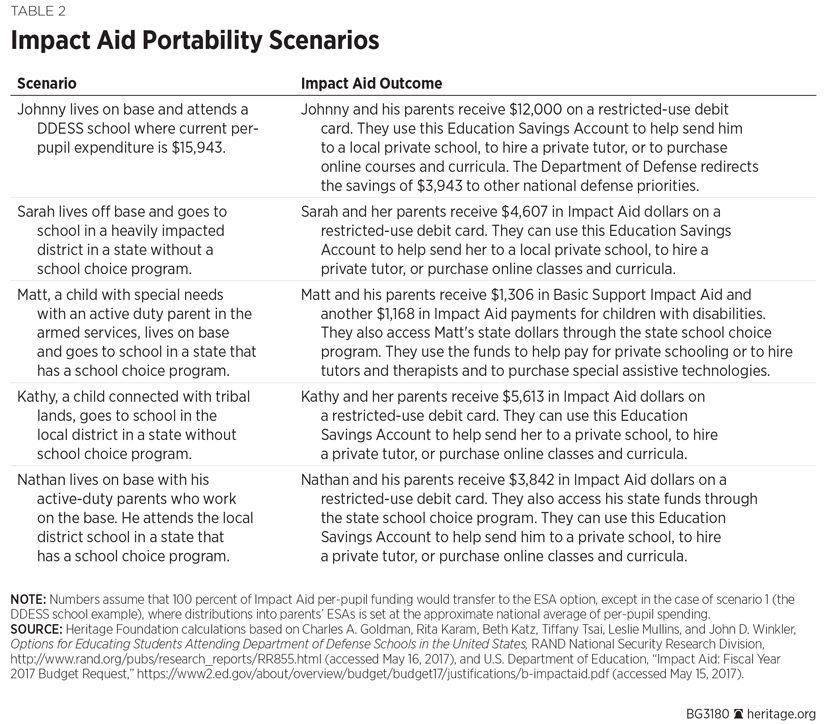
Policy Recommendations to Better Serve Those Who Serve
All children should have a choice in the school they attend. Parents are the best teachers of their children and have the fundamental right to direct the upbringing and education of their children. Moreover, as taxpayers, parents should be able to control where their education dollars are spent. The public financing of education should be separated from its delivery, and families should be able to direct their dollars to any education option that meets the needs of their children.
Recommendations for Federal Policymakers
Congress is limited in the vehicles available to federal policymakers to advance education choice in a constitutionally appropriate manner while also limiting federal intervention in local school policy. The education of military-connected children is one such vehicle that is appropriate. In order to expand the education options available to the children of members of the armed services, federal policymakers should:
- Transition Impact Aid funding into ESAs. Instead of filtering the $1.3 billion in federal Impact Aid funding to district schools, and then assigning students to those schools based on where their parents are stationed, Impact Aid dollars should be directed to eligible students. All Impact Aid dollars for military-connected children should go directly into a parent-controlled education savings account, which the family could then use to pay for any education-related service, product, or provider that meets the specific needs of their child. Oversight and management of the repurposed Impact Aid program should be transitioned to the DODEA.[REF]
- Transition the DDESS system into a system of ESAs for military families. Rather than maintaining DDESS schools on military bases at great expense, the DOD should transition funding for DDESS schools into parent-controlled education savings accounts. Given the high average per pupil expenditure of $26,682 at DDESS schools—an amount that more than covers costs at most private schools—the DOD could transition part of its current spending into flexible, parent-controlled accounts and use the savings to direct funds back to national defense priorities.[REF]
Recommendations for State Policymakers
- Create education choice options for all children, including military families. By adopting universal ESAs, states can empower as many students as possible with as many education options as possible. In the event a state wants to establish an education choice option specifically for children of members of the armed forces, they should allow all military-connected children to receive their share of state per pupil funding in the form of an ESA. In conjunction with the policy of transitioning the federal Impact Aid program into ESAs outlined above, a military-connected student could access both their state per pupil funding and federal Impact Aid funds in the form of parent-controlled ESAs, significantly increasing their educational purchasing power.
- Establish open-enrollment policies. At minimum, states should allow for inter-district and intra-district public school choice for military families, enabling them to enroll in any public school of choice, instead being confined to the district school closest to where they are stationed or have chosen housing.
An Education Approach Worthy of the U.S. Armed Forces
The number and quality of educational options available to children from military families affects military readiness, because education plays a role in whether a family accepts an assignment, even factoring into decisions to leave military service altogether.[REF] Important as education is to military parents, more than half of all active-duty military families live in states with no school choice options at all. In order to ensure those who serve in the military to protect the U.S. are able to access education options that serve them in the best way possible, federal policymakers should work to empower children of military families with education choice. Transitioning Impact Aid funding into parent-controlled education savings accounts would provide children of active-duty military families with education choice, while ensuring the federal program serves military families as well as they serve us.
—Lindsey M. Burke is the Will Skillman Fellow in Education and Director of the Center for Education Policy, of the Institute for Family, Community, and Opportunity, at The Heritage Foundation. Anne Ryland is a Research Assistant in the Center for Education Policy. Dakota Wood, Senior Research Fellow for Defense Programs in the Center for National Defense, of the Kathryn and Shelby Cullom Davis Institute for National Security and Foreign Policy, at The Heritage Foundation, contributed to the formulation of this Backgrounder.
Appendix and Tables
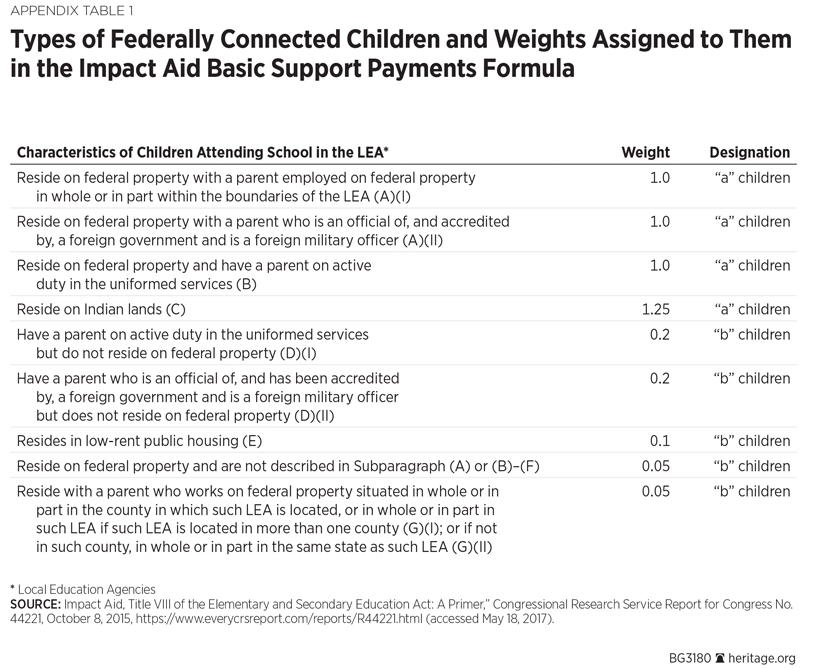
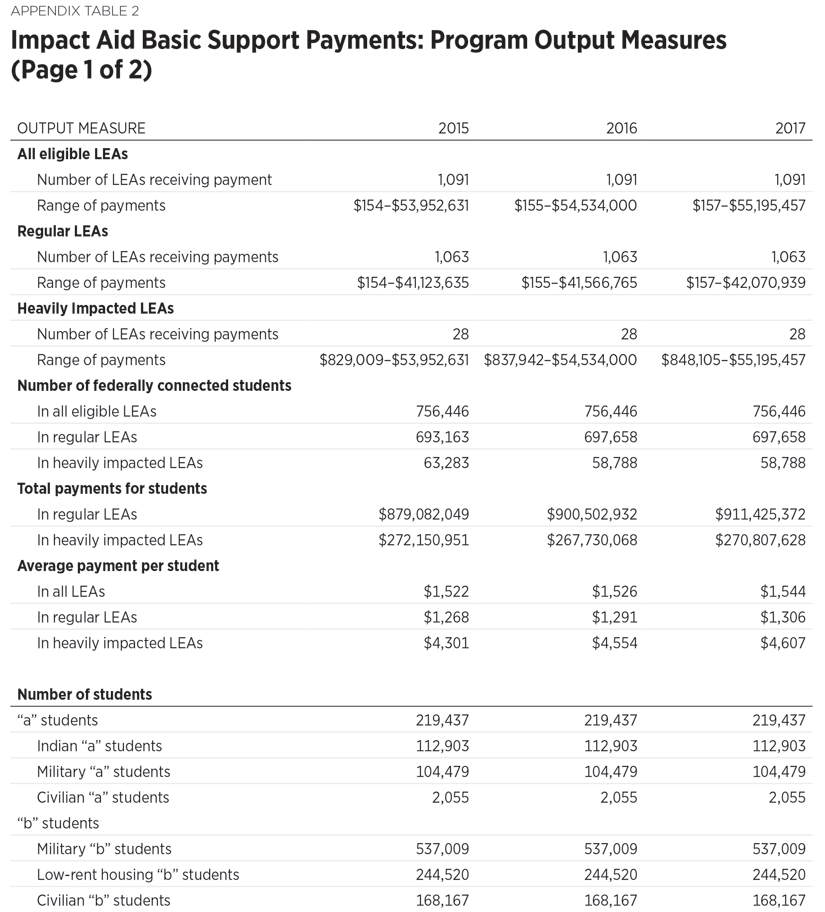
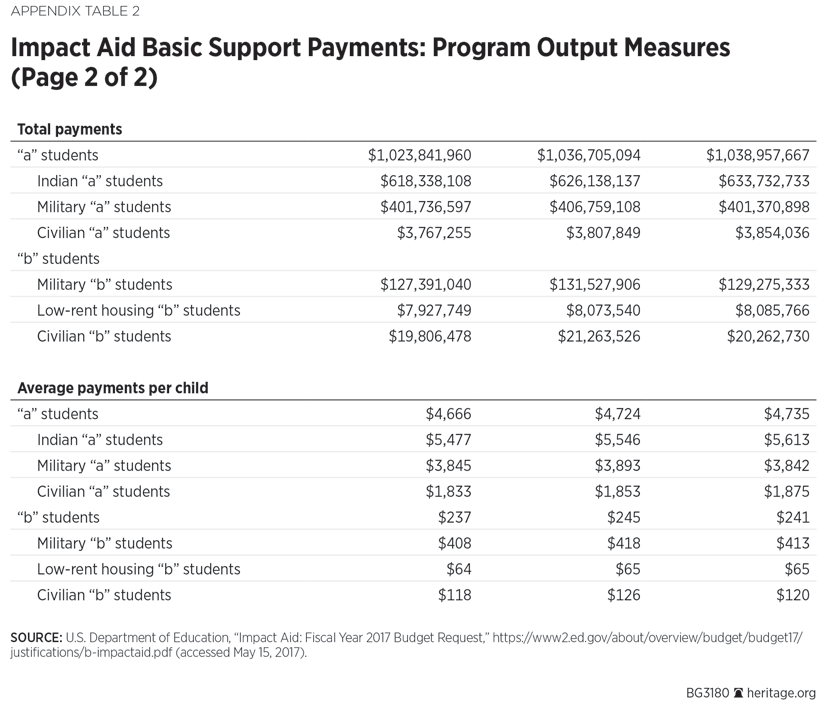
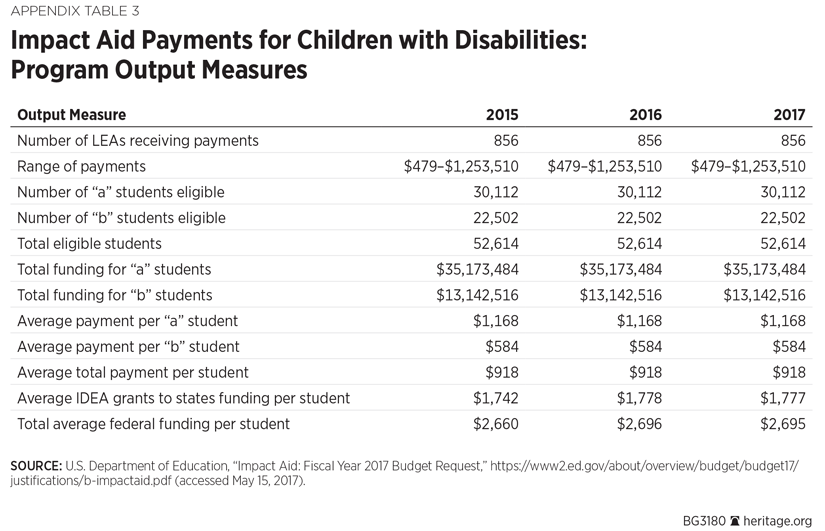
Local education agencies are eligible for compensation under Section 8003(b) if they educate at least 400 federally connected children or at least 3 percent of average daily attendance (ADA).[REF] Federally connected children include:
- Children with parents in the military,
- Children living on tribal lands,
- Children of civilian federal employees, and
- Children living in low-rent housing.
Because the different types of federally connected children create varying degrees of burden in education costs and tax losses, each classification of student is weighted differently. (See Table 2.) Children living on tribal lands are weighted most highly. Children living on federal lands whose parents are employed on federal land or are active-duty military are also high-weighted. All three of these types are commonly referred to as category “a.”[REF] Children receiving lower weights are referred to as category “b” and include:
- Children who do not reside on federal property but have a parent who is active-duty military,
- Children of foreign military officers,
- Children who reside in low-rent public housing,
- Children who live on federal land but whose parents do not work on federal land, and
- Children whose parents work on federal land, but do not live on federal land.
This program is funded retroactively:
- LEAs give the DOE their totals for each type of federally connected student in a given year.
- The DOE calculates maximum payments by multiplying the weighted student totals by the Local Contribution Rate (LCR)—a measure of per pupil expenditure for the area; reduces payment amounts if appropriations are insufficient to make maximum payments; and sends the payment to the LEA where is it usually deposited into the general operating fund.[REF]
A total of 1,091 LEAs received payments under the Basic Support payment program in 2016.[REF]
The complex statutory system for distributing Impact Aid Basic Support payments has only grown more complex because the Impact Aid program is not fully funded. Since appropriations are never sufficient to cover maximum payments for all LEAs (an estimated $2.15 billion would be required), statutory mechanisms were introduced to prorate payments so that districts that are more dependent on Impact Aid receive higher percentages of their maximum payments than districts that are less dependent.
A new formula was developed to calculate a Learning Opportunity Threshold (LOT) payment for each district. This LOT payment is determined by adding the federally connected percentage of an LEA’s ADA to the Impact Aid payments percentage of the LEA’s total current expenditure, and multiplying this percentage—which must not exceed 100—by the maximum payment.
Basic Support Payments for Heavily Affected Districts
As part of this effort to prioritize funds to the districts that need them most, statutory changes also introduced a distinction between Regular Basic Support Payments (Section 8003(b)(1)) and Basic Support Payments for Heavily Impacted LEAs (Section 8003(b)(2)).[REF]
In 2016, 28 LEAs qualified as heavily impacted. Eligibility criteria are based on the LEA’s tax rate and the percentage of federally connected children of various types in ADA.[REF] Calculations for these LEAs are similar to those for Regular Basic Support LEAs, but adjusted to ensure that maximum payments for these LEAs are much higher and that the LEAs get full funding first. For these districts, certain classifications of students are weighted more highly: The LCR is calculated using a higher per pupil expenditure as reference, and their LOT percentages are always 100 percent. Thus, if funds are sufficient, the LEAs receive 100 percent of their maximum payment calculation.[REF] If the DOE cannot both fully fund heavily impacted districts and give regular LEAs 100 percent of their LOT payments, payments to all LEAs are reduced by the same percentage. According to the Congressional Research Service, in FY 2015, heavily affected districts received 34 percent of the total funding for Basic Support payments, “over four times the amount per child that regular Impact Aid LEAs receive.”[REF]
Basic Support Payments: Section 8003(d)
Impact Aid money for federally connected children in both regular basic support LEAs and heavily affected LEAs does not have to be used for a specific purpose, and typically goes directly into the general operating fund for the district.
However, payments under Section 8003(d) are designated for federally connected children with disabilities and are intended to supplement the basic support payments to help provide for the increased cost of educating a child with special needs. These payments must be used specifically to support education for an LEA’s Individuals with Disabilities Education Act (IDEA) eligible children. The DOE uses a weighting system similar to the system under regular basic support payments in order to calculate how much an LEA will receive for its students with disabilities. In 2016, the DOE distributed $48.3 million in Impact Aid dollars to 52,614 eligible students with disabilities.[REF]
Impact Aid: Department of Defense Aid and Other Education Initiatives
Because Impact Aid through the DOE is not fully funded, the DOD also contributes supplemental Impact Aid to help “ensure that school districts with significant numbers of military dependent students have additional funding in order to maintain certain educational standards.”[REF]
The DOD provides supplemental funds of two kinds:
- To LEAs that are educating significant numbers of military dependents, and
- To LEAs that are educating military dependents with severe disabilities.
LEAs are selected to receive supplemental assistance funds if 20 percent or more of their ADA is military dependent, and if the Secretary of Education and Secretary of Defense determine that, without the funds, the LEA will be unable to provide a level of education on par with the minimum level of education in other LEAs in the state.[REF] According to a Government Accountability Office (GAO) report from 2011, about 120 districts receive funds from this program.[REF] The DOD will also reimburse LEAs with at least two severely disabled military dependent students for expenses paid if their expenditures significantly exceed national and state per pupil expenditures for similar students and services.[REF] The GAO reports that approximately 40–50 districts are awarded funds each year under this assistance program.[REF] In 2015, a total of $30 million was appropriated for these two DOD Impact Aid programs, $25 million for supplemental assistance, and $5 million for military students with severe disabilities.[REF]
The DOD also tries to provide help to military families and impacted districts through programs like Tutor.com, a free tutoring service available to military dependent students for all grade levels and academic subjects, and through competitive grants from DODEA. Since 2009, DODEA has awarded over $400 million in grants to LEAs that serve military children, and have awarded grants to partners like the National Math Science Foundation.[REF] Overall, the DOD continues to invest significantly in the education of military dependents; however, as the 2011 GAO report found, more information is needed to assess whether military students are actually reaping the benefits.[REF]



